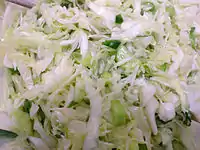Coleslaw
Coleslaw (from the Dutch term koolsla meaning 'cabbage salad'), also known as cole slaw or simply slaw, is a side dish consisting primarily of finely shredded raw cabbage[2] with a salad dressing, commonly either vinaigrette or mayonnaise. Coleslaw prepared with vinaigrette may benefit from the long lifespan granted by pickling.[3]
 Coleslaw made with mayonnaise | |
| Alternative names | Slaw |
|---|---|
| Type | Salad |
| Course | Side dish |
| Place of origin | Netherlands[1] |
| Main ingredients | Fine shredded raw cabbage; vinaigrette (acetic acid (vinegar essence) or vinegar, vegetable oil, salt) or mayonnaise and salad cream |
History

The term "coleslaw" arose in the 18th century as an anglicisation of the Dutch term "koolsla" ("kool" in Dutch sounds like "cole") meaning "cabbage salad".[4][5] The "cole" part of the word comes from the Latin colis, meaning "cabbage".
The 1770 recipe book The Sensible Cook: Dutch Foodways in the Old and New World contains a recipe attributed to the author's Dutch landlady, who mixed thin strips of cabbage with melted butter, vinegar, and oil. The recipe for coleslaw as it is most commonly prepared is fairly young, as mayonnaise was invented during the mid-18th century.
According to The Joy of Cooking (1997), raw cabbage is the only entirely consistent ingredient in coleslaw; the type of cabbage, dressing, and added ingredients vary widely. Vinaigrette, mayonnaise, and sour cream based dressings are all listed; bacon, carrots, bell peppers, pineapple, pickles, onions, and herbs are specifically mentioned as possible added ingredients.[5]
Use
Coleslaw is generally eaten as a side dish with foods such as fried chicken and barbecued meats and may be accompanied by French fries or potato salad as another side dish. It also may be used as a sandwich ingredient, being placed on barbecue sandwiches, hamburgers, and hot dogs along with chili and hot mustard. Coleslaw also is used on a variant of the Reuben sandwich, with coleslaw substituting for the sauerkraut; the sandwich is commonly called a Rachel to differentiate it from the Reuben.
Cabbage salad variations
There are many variations of the recipe, which include the addition of other ingredients such as red cabbage, pepper, shredded carrots, onion, grated cheese, pineapple, or apple, mixed with a salad dressing such as mayonnaise or cream. A variety of seasonings, such as celery seed, may be added. The cabbage may come in finely minced pieces, shredded strips, or small squares. Other slaw variants include broccoli slaw, which uses shredded raw broccoli in place of the cabbage. Cream, sour cream, or buttermilk are also popular additions. Buttermilk coleslaw is most commonly found in the southern United States.

Germany
Traditional German Krautsalat consists of finely shredded cabbage marinated with oil and vinegar. Sometimes onions or apples are added.
Italy
Coleslaw with cooked ham and sliced pepper (julienne cut) in Italy is called insalata capricciosa (capricious salad).
Poland
Various cabbage-based salads that resemble coleslaw are commonly served as a side dish with the second course at dinner, next to meat and potatoes. There is no fixed recipe, but typical ingredients include shredded white cabbage (red and Chinese cabbage are also not uncommon), finely chopped onions, shredded carrots, and parsley or dill leaves, with many possible additions. These are seasoned with salt, black pepper and a pinch of sugar, and tossed with a dash of oil (typically sunflower or rapeseed) and vinegar, while mayonnaise-based dressings are uncommon. An alternative, usually served with fried fish, is made with sauerkraut, squeezed to get rid of excess salty brine and similarly tossed with carrots, onions, black pepper, sugar and oil.
Any simple salad of that kind, i.e. one made with shredded raw vegetables, is known as a surówka (Polish: surowy 'raw'). If cabbage is the base ingredient, it is simply called a surówka z (kiszonej) kapusty, or a "(soured) cabbage salad". The English name "coleslaw" is mainly associated with the mayonnaise-dressed cabbage. It is often written as "colesław" or "kolesław", because of the similarity to many names ending with "-sław" (e.g. Bolesław).
Russia and Ukraine
In Russia and Ukraine, a salad of fresh shredded cabbage, mixed with carrots, apples, cranberries etc., is traditionally dressed with unrefined sunflower oil.[6] The cabbage can be marinated before with vinegar producing cabbage provençal (Russian: капуста провансаль, tr. kapusta provansal).[7] A similar salad is also made of sauerkraut.[6]
Sweden
In Sweden, a particular type of cabbage salad made with a vinaigrette consisting of vinegar or acetic acid (vinegar essence), vegetable oil, salt, and seasonings is classically served with pizza and known as pizzasallad (pizza salad).[8] Recipe adds carrots and leeks and is called veckosallad (week salad) for its notable durability. The term coleslaw (Swedish: coleslaw, or Swedish: kålsallad) is reserved for cabbage salad with carrots and mayonnaise-based dressing, and is typically seen as part of the American cuisine.
United Kingdom
In the United Kingdom, coleslaw often contains carrot and onion in addition to cabbage, and is often made with mayonnaise or salad cream. Some variations include grated cheese such as cheddar, or nuts such as walnuts and dried fruits such as sultanas or raisins.
United States
In the United States, coleslaw often contains buttermilk, mayonnaise or mayonnaise substitutes, and carrot, although many regional variations exist, and recipes incorporating prepared mustard or vinegar without the dairy and mayonnaise are also common. Barbecue slaw, also known as red slaw, is made using ketchup and vinegar rather than mayonnaise.[9] It is frequently served alongside North Carolina barbecue, including Lexington style barbecue, where, unlike in the rest of the state, a red slaw is the prevailing variety.[10]
See also
- Cabbage stew
- Cheese slaw
- Chow-chow – Relish
- Curtido – A type of lightly fermented cabbage relish from Central America
- Kimchi – Traditional Korean side dish of salted and fermented vegetables
- List of cabbage dishes – Wikipedia list article
- Pao cai – A type of pickle in Chinese, and particularly Sichuan cuisine
- Sauerkraut – Finely sliced and fermented cabbage
- Suan cai – Traditional Chinese pickled vegetables
References
- Engelhardt, Elizabeth (2009). Republic of barbecue : stories beyond the brisket. Austin: University of Texas Press. p. 17. ISBN 978-0292719989.
- "Coleslaw – Definition and More from the Free Merriam-Webster Dictionary". Merriam Webster. Retrieved 9 September 2018.
- "Pickled Cabbage Salad".
- Perelman, Deb. (2007-08-08) "Coleslaw: You Could Be a Star". NPR. Accessed 2009-06-24.
- Rombauer, Irma S.; Becker, Marion Rombauer; Becker, Ethan (1997). Joy of Cooking. New York: Scribner. pp. 222. ISBN 0684818701.
- Peter Vatrooshkin (2012). Easier Than a Steamed Turnip: Simple and Delicious Meatless Russian Recipes. Plutagora LLC. pp. 21–22, 27, 28. ISBN 9781938407017.
- Alexandra Grigorieva (2010). Richard Hosking (ed.). "Russian Food Words at Home and Abroad". Food and Language: Proceedings of the Oxford Symposium on Food and Cooking 2009. Oxford Symposium: 149. ISBN 9781903018798.
- "Pizzasallad - Recept från Spisa.nu".
- ABC News, (2009-06-05). "Lexington Red Slaw" Archived 2011-06-29 at the Wayback Machine WLS-TV/DT Chicago, IL. Accessed 2009-06-24.
- Mercuri, Becky (2007-03-05). The Great American Hot Dog Book: Recipes and Side Dishes from Across America. Gibbs Smith. p. 76. ISBN 9781423600220. Retrieved 21 April 2012.
External links
 The dictionary definition of coleslaw at Wiktionary
The dictionary definition of coleslaw at Wiktionary

